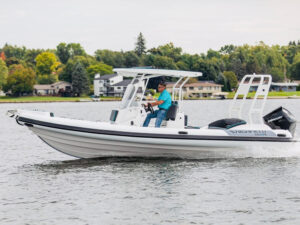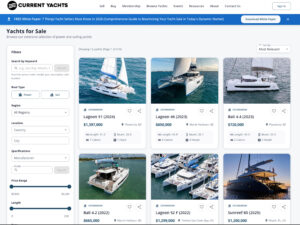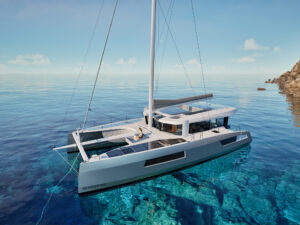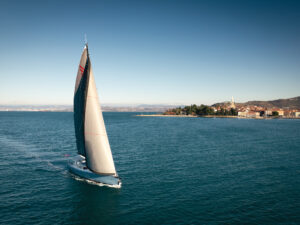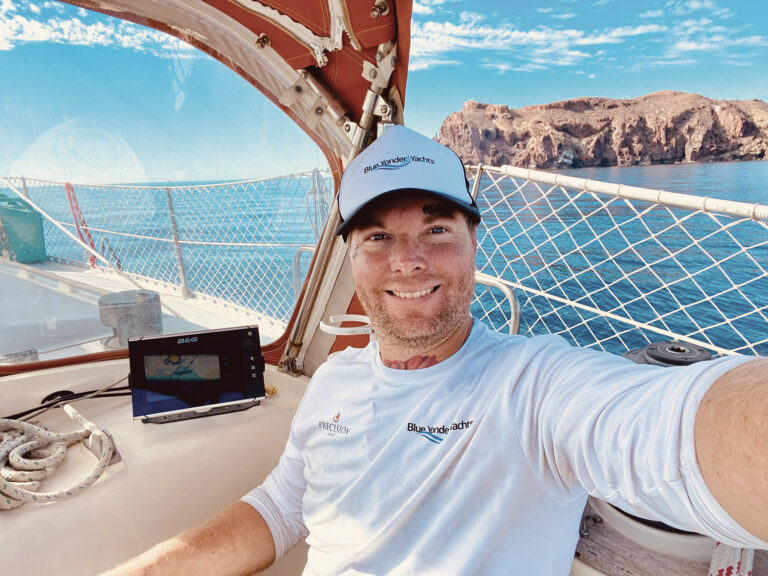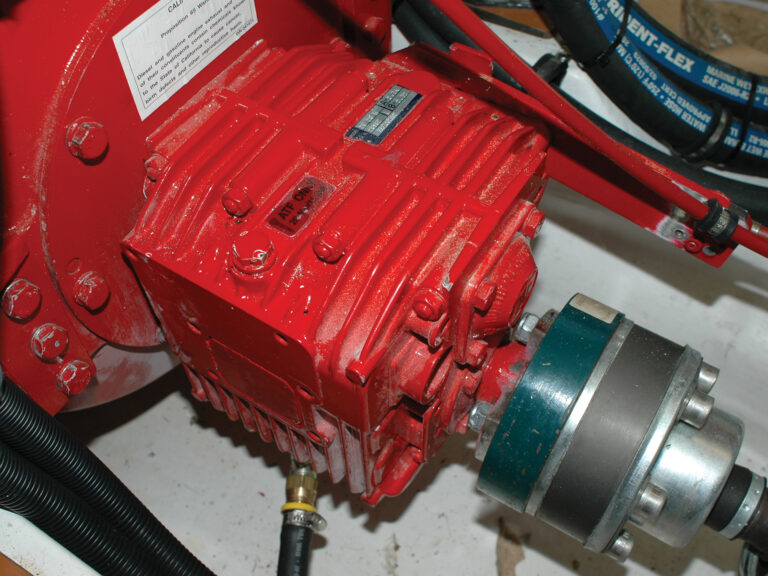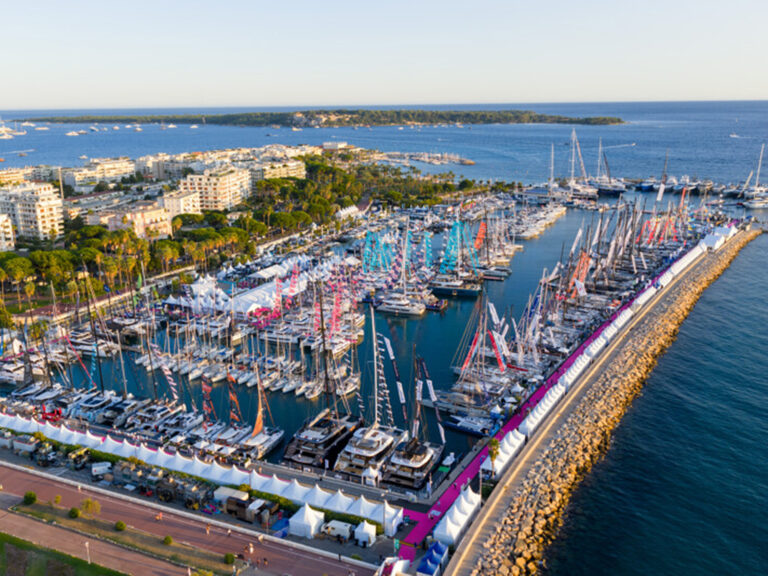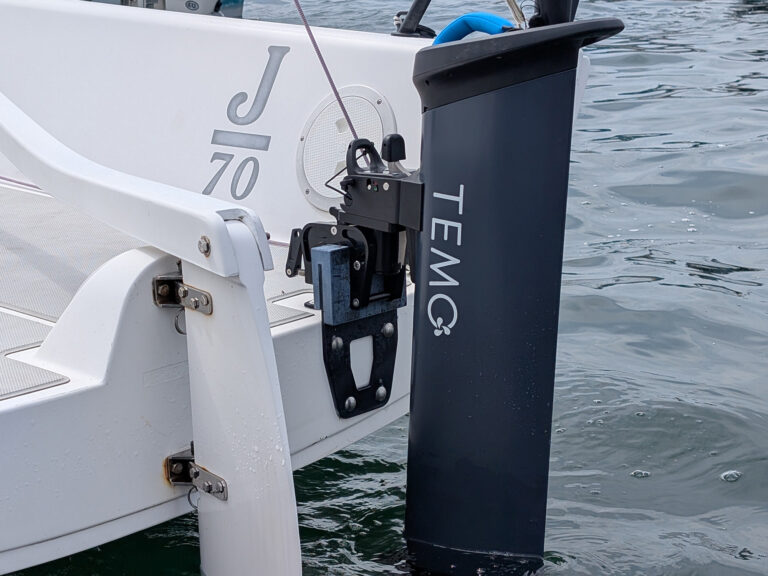
Trintella 50 368
The night before we were to take the new Trintella 50, Valour, out for a sail on Chesapeake Bay, her owner, Hal Denton, and captain, Tom Lawton, and I were up late talking. It was a chilly spring night, and we sat in the boat’s distinctive midships cuddy, surrounded by large glass windows forward and on the sides. We didn’t bother with the canvas that can seal this space off from the elements, making it a perfect place to stand a watch in wild, wooly weather, and no one bothered to turn on its heater. We certainly didn’t need the AC.
We’d gone to dinner ashore earlier, and it was there that Hal started to explain how a lifelong powerboater had, in middle age, jibed about, learned to sail, then set his sights on some of the toughest passages around: the Fastnet, Newport-Bermuda, and Sydney-Hobart races. Those races-plus the grandkids (more on that later)-prompted him to take what he’d learned from his old boat, a Trintella 47, and ask its designer, Ron Holland, to stretch the envelope by three feet to produce an any-ocean cruiser to Hal’s liking.
As Hal talked on into the night, a twisting story emerged of an ambitious owner, an internationally renowned designer, a builder in transition, and the intertwined paths that all led to Valour.
Oh, where to start. Well, first, meet Hal, the CEO of a large land-title insurance company and a recovering fox hunter and gentleman farmer with a 110-acre spread outside Princeton, New Jersey, and a wife who loves horses. Hal grew up in the Midwest, got his first taste of salt water during a three-year tour in the Navy, then spent 30 years owning a succession of powerboats with which he and his partners entertained clients. Summers, he’d wine and dine guests in New York or along the Jersey shore. Winters, they’d move the boats and the parties to Key West. These were big boats, trawlers, with semi-displacement hulls in the 50- and 60-foot range, and they were Hal’s passion.
Next, meet Hal’s heart doctor. Ten years ago he told his ailing patient that he needed to relax; he suggested that Hal try sailing. The doctor, says Hal, didn’t know much about the sport and pictured a daysailer on some lake and the skipper trailing his hand in the water on a warm summer day. Hal was skeptical.
“I was a happy powerboater,” he says. “I thought sailboats were pretty stupid. They didn’t go very fast, and sailors could never get where they were going.”
But doctor’s orders are doctor’s orders, so he bought himself a Bayfield 25, an older Canadian boat that he remembers being as heavy as a rock. He also recalls it as the perfect boat for a beginner because it was most forgiving and, with its shallow draft, near impossible to run aground.
Next thing you know, Hal, then in his 50s, was having a ball. He took the Bayfield out six times and realized you could tinker endlessly with a sailboat. And, God forbid, should you get the sails in perfect trim and suddenly have nothing to do, the wind would change and you could start all over again.
Next, there was that business partner of Hal’s, who in the 1970s bought an Intrepid 9-Meter. Unimpressed at the time, a now-enlightened Hal recalled that it was a pretty nice sailboat, so he went out and found it, hull number 23, and in 1998 he bought it and set to restoring it. Who knew: Not only did Hal like sailing boats; he also enjoyed all that’s involved in fixing and building them, too. Soon Hal was back in his winter waters of Key West, but this time with the Intrepid. He hired a local character to sail with him every day and yell at him if he made a mistake.
Next thing you know, Hal was walking like a sailor, talking like a sailor, and hanging around with sailors, and they tempted him to take a bite from the forbidden fruit: He entered his first race.
So what was his heart doctor thinking by about 2000, when Hal took delivery of a new Trintella 47? With its cuddy amidships and aft cockpit, it allowed Hal to invite guests aboard and entertain in style. Its wide bridgedeck above meant below there was room for standing headroom in the starboard-side passageway to the aft cabin, a spacious area that soon became his personal hotel room when in Florida or in New York City.
“I love beautiful, high-quality things. The 47 made me smile every single time I went aboard,” he says.
Meantime, Hal chartered a hot-rod raceboat, a Henderson 30, for one Key West Race Week and soon found himself buying one of the first Beneteau 36.7s, joining owners who were forming their own one-design fleet. He put the boat in Annapolis, Maryland, near Washington, D.C., where his two boys, Taft and Reed, live, figuring they could race with him on weekends and use the boat themselves the rest of the time. And if they got into sailing, so would their wives and eventually their kids (still none of those born yet). Hal’s game plan envisioned the day when his wife would have to adjust to boating if she wanted to see her grandchildren.
With that in mind, along with thoughts of long-distance ocean races tugging at him, he needed a new boat, one that could cross oceans and then be a well-appointed floating home for his wife and the next generation of Dentons. He was ready for a new Trintella.
Lightning Strikes the Netherlands
The seeds of Trintella Yachts were planted in 1953, when Dutch harbormaster Anne Wever set up shop in Den Bosch, in the Netherlands, and began building wooden Lightnings. Soon, he met Dutch yacht designer E.G. van de Stadt, and before the decade came to a close, the first van de Stadt-designed steel-hulled sloop was launched, featuring a mahogany cabin top and named Trintel, after a local sandbank. The sailboat was a hit with sailors and added to Anne’s growing reputation as a builder of quality boats. In the early 1960s, his yard became the first in Europe to be tempted by the potential of fiberglass hull construction, and in 1964 Anne built the Trintella, which van de Stadt designed to take advantage of the new material. As would be the trend for years to come, the hulls were laid up in England, then sent to the Netherlands to be finished by Dutch craftsmen. For the next 20 years, Anne turned out new models built in both fiberglass and later aluminum, the largest of which was the Trintella 75. By then, his company was focused squarely on high-end, semicustom boats.
In 1989 Anne retired. The Trintella name was sold to British investors, who turned to Ron Holland in 1994 to design the composite-built Trintella 47, the model that Hal would eventually buy.
These new investors, said Hal, quickly learned that building boats was an involved hobby-and an expensive one, thanks to Dutch labor costs. By the time Hal ordered his 47, Trintella Yachts was open to new ideas, and his boat was built at the Westerly yard, which the company owned in England.
By 2003, the British investors had determined that boatbuilding wasn’t for them, and the company was placed into receivership. Hamble Yacht Services eventually bought the company and completed a Trintella 55 that was already in the works, then built Hal’s new Trintella 50.
Laying Out Valour
Hal jokes that in addition to what he paid the builder, the Trintella 47 cost him a Dutch horse for his wife. The 50, he says, cost him two German horses as his wife embarked on an intensive two years of dressage training in Germany. But he doesn’t complain; her frequent trips to Europe allowed him the opportunity to visit the Hamble yard often during Valour’s construction.
Hal had gone to Ron Holland looking for a boat with more speed than the 47, more room below to accommodate a crew of eight, and with a layout that would be luxurious for entertaining and cruising but functional when beating offshore in race conditions. To increase volume below, a foot and a half was added to the midsection of the 47’s mold and another foot and a half to the stern.
Ron says that little was changed in the forward sections of the boat, but he modified the treatment of the overhang on the stern. The result is a more elegant look, he says, and added usable space.
Like the 47, the new 50 would sport a cuddy and a lounging area on deck amidships and a cockpit aft, where the helm and sail controls are located. In laying out both the deck and the interior, Hal said the idea was to create both spaces where the crew (or clients) could come together as well as places where you could find privacy on a long passage.
Going down the companionway steps, you enter a saloon that’s a few inches shorter in length than on the 47, in part because the keel-stepped mast dictates how space can be allocated. To port there’s a small table and an L-shaped settee, with red-leather cushions, that can be converted into a full-size sea berth. A portion of the short side of the L can be removed, along with a part of the sole in front of it, so a box and waterproof curtains can be installed to hold foul-weather gear for those coming off watch when racing.
To starboard is a compact nav station packed with electronics. Aft of the saloon to port is a captain/crew cabin (or the bunk room for the grandkids). On many of the 47s, that space was used instead for a walk-in engine room. To starboard is an inline galley and passageway to the owner’s cabin aft. In addition to the usual stove, fridge, freezer, and sink, the galley includes a dishwasher and a cappuccino machine-the latter a hit during late-night watch changes. Access to the 85-horsepower, five-cylinder Nanni diesel and 8-kilowatt Mastervolt generator is through panels on either side of the engine space.
The aft cabin is roomy, functional, and beautifully appointed. A waterproof wiring closet is concealed behind rich ash paneling-the same light-colored wood that’s used throughout the boat-and there’s a head and shower that’s also shared by the captain’s quarters, since the other head is all the way forward, with access only through the forward cabin. Lee cloths make the queen-sized berth a suitable space for two crew when racing.
The cabin forward at first seems unusual. To port there’s a berth that’s bigger than a single but not a full-sized double, and over it, there’s a slide-out berth; its mattress doubles as a deck cushion for a get-away lounging space in front of the mast on the wedge-shaped cabin top. To port there’s what might be called an upper berth, nearly chest high, with storage lockers underneath.
After spending the night here, though, I’d have to say the layout works. My bunk could be used by a couple, and the upper opposite would be fine for kids or a nimble single. With an overhead hatch and ports in the hull, the space is bright and pleasant by day and cozy at night.
All told, in racing mode there are six good sea berths, and once back in the harbor, where the aft cabin won’t be pitching, there’s two more, so every one of the eight crew can recover from the parties in comfort. Oh, and with a watermaker, there are showers for all every morning, Hal adds. No stinky crew on his boat!
By going with a carbon-fiber rig, Ron Holland cut down the weight of the spar in comparison with the 47, and he was able to add a yard to the mast while only increasing the depth of the keel by a foot. At 37,400 pounds, the 50 hit the water a few pounds lighter than the old 47.
The hull is a multilayer composite of SCRIMP-molded vinylester, Kevlar, and aramid fibers; the balsa-cored deck is finished with hand-laid 12-mil teak.
Rather than a line-driven Leisure Furl boom, as on the 47, Valour has an electric-drive Leisure Furl; it was dunked during a broach on the boat’s delivery north from Fort Lauderdale, Florida, and wasn’t working for our sail. After spelling the captain when it came time to crank down the sail using a conventional winch handle, I’d go with a new motor, if it were my boat. Or hire a bodybuilder for crew.
So how did Valour sail? To be honest, it was difficult to get a real feel for the boat in the 10 knots or so of wind that we had to work with both on that spring day in May and on the day last fall when the CW Boat of the Year judges sailed her, also off Annapolis. The day we had the judges on board, I can tell you that they loved the way the sail-control lines were clustered at a single workstation at the mast, the easily navigated decks, the responsiveness of the wheel, and how every step, handrail, and piece of hardware seemed to be in the right spot. They named the Trintella 50 as Best Full-Sized Cruiser for 2007.
And I can tell you that on the morning Hal, Tom, and I beat north under the Annapolis Bay Bridge, Valour tacked effortlessly, thanks to her solent rig and self-tending jib. We managed a speed over the ground of 6.5 knots with 11 knots of true wind, and we were closehauled at about 30 degrees of apparent-wind angle. Off the wind, with the 140-percent genoa rolled out, we ghosted our way back down the bay as the wind died and the water eventually turned to glass.
By Tom’s account, it would’ve been more fun to be aboard this past winter, on the way to the finish of the Fort Lauderdale-to-Jamaica Pineapple Cup. With 45 knots screaming over the deck, Valour was in her element, sails set and crew determined-a perfect place to hone skills for what was planned then to be the last waltz with Hal’s three grand dames of ocean racing, the Sydney-Hobart Yacht Race.
After taking delivery of Valour at the Hamble yard in 2005, she sailed the Round the Island Race, a qualifying race to France, and then the Fastnet. Hal then loaded the boat on a ship and had her sent to Baltimore. In 2006, he and his crew sailed the centennial running of the Newport-Bermuda Race.
But toward the end of our sail on what was turning out to be a delightfully warm Maryland spring day, Hal said the prospects of Valour seeing the Tasman Sea under his command were getting increasingly dim, in part because of health concerns. His reasoning included his belief that it wouldn’t be fair for the crew to have to deal with the aftermath of a stricken skipper. The future, he said, may instead involve more daysailing or, ironically, even a return to the powerboats he still owns, if, in fact, that’s what the doctor orders.
So with a potential change in plans, our conversation wound down with a tinge of sadness, though Hal brushed away any mention of regrets. The best part of building and owning two beautiful sailing machines? It’s the people, of course.
“I’ve had wonderful relationships that will be lifelong with my crew and with the people who build these boats,” said Hal.
Mark Pillsbury is CW’s senior editor.

